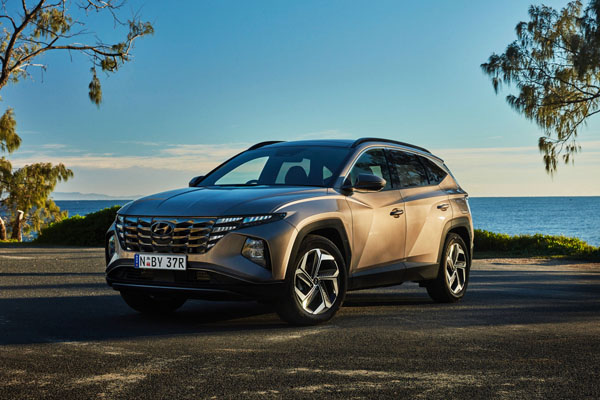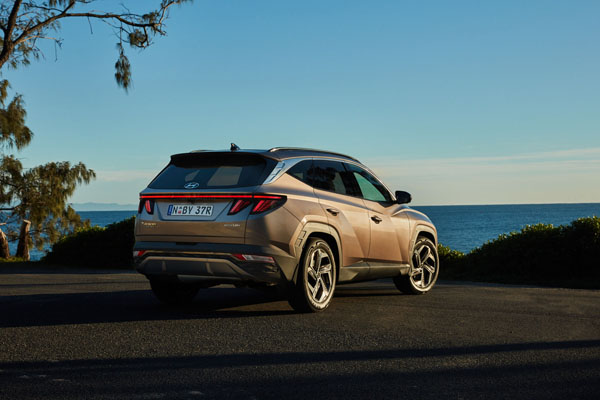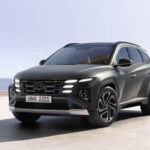
The best family car, I’ve always said, would be a sporty two-seater that won’t take unruly kids or a slavering pet dog. I jest. But seriously, when it comes to sports utility vehicles, a mid-size five-seater (not seven seats), like the Hyundai Tucson, fits the average family bill.
It will take up to five in comfort, plus the family Fido, and a fair amount of kit at the same time. Best of all, lurking under a flat cargo floor, the latest model has a full-size spare, so any encounter, on or off road, with a puncture avoids any cosmic crisis involving a temporary wheel, run-flat tyre or inflation kit.
The Tucson range has been simplified for model year 22, with three variants – Tucson, Tucson Elite and Tucson Highlander – on offer, with three new Smartstream powertrains, including 2.0-litre petrol, 1.6-litre turbo-petrol and 2.0-litre turbo-diesel engines.
The Tucson surely misses its way with the maker’s tag of ‘Tomorrow’s car today’. Electrification, we are sure, will be the way of the automotive world, including the SUV segment, in the future.
The latest Tucson, with no EV or even hybrid model, is literally powerless against rivals such as Nissan X-Trail, Mitsubishi Outlander, Toyota RAV4 and Subaru Forester on the horizon or here already.

Hyundai touts futuristic styling, segment leading technology, including the most safety tech in class, and an across-the-board optional N Line package, the latter introducing sporty 19-inch alloy wheels, LED front and rear lighting and 10.25-inch LCD instrument cluster and leather and suede upholstery.
On test was a Tucson Elite 2.0 MPi six-speed automatic with front wheel drive, which sells for $39,000, plus on-road costs. An N Line Pack adds $2000 to the Elite price, premium paint $595.
STYLING
Hyundai’s futuristic foray with the Tucson begins on the outside. There’s nothing lightweight about the looks. It’s all bold curves and geometric shapes in metal or metallic-look materials.
A jazzy radiator grille is flanked by a distinctive lighting set-up, which sets the story for a futuristic profile with a dominant Z-shaped graphic, fulsome wheel arches and side garnish, plus integrated contrasting black roof rails.
A broad back, with wide-set lighting, incorporates a new glass-type Hyundai ‘H’ emblem.
INTERIOR
The fourth-generation Tucson is bigger than before, with long bonnet and shorter overhangs on an extended wheelbase, which translates to more space in the cabin.

The surroundings are generally down-to-earth and even on the bland side. However, there is much to praise, including bridge-style centre console, classy leather upholstery, heated front seats and electrically adjustable driver’s seat, dual-zone air-conditioning, smart key and push-button engine start / stop.
INFOTAINMENT
There’s little of the Marvel-style comic-book exterior carried over inside. While there’s room for the latest in automotive technology, with 10.5-inch LCD digital instrument cluster and 10.25-inch touch multimedia display.
The latter is situated on the top of the dashboard to provide excellent line of sight navigation, audio and other info for the driver and front seat passenger. Users have the option of wide-screen or split-screen view of map or navigation and audio.
Apple CarPlay or Android Auto connectivity is transposed from handsets to the in-dash multimedia touchscreen. Wireless phone charging is available across the Tucson range.
ENGINES / TRANSMISSIONS
Fitted to the test car was an all-new Smartstream 2.0-litre petrol engine with front-wheel drive and six-speed automatic transmission – one of three powertrains on offer across the new Tucson range.
.
SAFETY
Like all new Tucsons, the Elite takes advantage of the latest version of Hyundai’s Smartsense driver assistance and advanced safety systems, some making their segment debut here. Passive safety is taken care of by a Hyundai-first seven airbags, including front, side, curtain and front-centre.
The last is mounted in the left of the driver’s seat backrest and stops serious injuries between front passengers or the interior in the event of a side impact.
The latest Smartsense suite features segment debutants blind-spot collision avoidance assist, blind spot view monitor and remote parking assist, while new for Tucson are surround view monitor, parking collision avoidance assist, lane follow assist, intelligent speed limit assist multi-collision braking and rear cross-traffic collision avoidance.
DRIVING
Unlike most Hyundais, the Tucson has sidestepped local ride-and-handling development by Australian chassis engineers, relying on tuning from its Namyang R&D centre.
The maker claims the vehicle was put through gruelling testing on the full spectrum of challenging conditions it was likely to come up against Down Under. Local feeling (mine too) is the new Tucson is highly capable.
The 2.0-litre petrol engine, developing 115 kW and 192 Nm is also capable without being a stand-out by modern standards. The Tucson showed some hesitation when asked to get a move on under pressure.
Fuel economy could not be questioned, with 9 litres-plus per 100 kilometres in mixed suburban conditions and 5 litres per kilometre when cruising on the open road. The maker claims 8.1 litres per 100 kilometres on the combined urban / highway cycle.
As mentioned above, the spacious cabin comfortably carries five adults, plus 539 litres of cargo out back on a flat floor. This can be extended to a voluminous 1860 litres with the second-row seatbacks remotely folded. A rear seat alert reminds the driver to check the seats are empty when leaving the vehicle.
SUMMARY
Advantages of the new Tucson are the spacious cabin and wide choice of conventional powertrain. The latest version is left behind rivals in seating capacity (no seven-seater) and the lack of some sort of electric propulsion.
AT A GLANCE
MODEL LINE-UP
Hyundai Tucson 2.0 MPi FWD $34,500
Hyundai Tucson Elite 2.0 MPi FWD $39,000
Hyundai Tucson Highlander 2.0 MPi FWD $46,000
Hyundai Tucson Elite 1.6 T-DGi AWD $43,000
Hyundai Tucson Highlander 1.6 T-DGi AWD $50,000
Hyundai Tucson Elite 2.0 CRDi AWD $45,000
Hyundai Tucson Highlander 2.0 CRDi AWD $52,000
Note: These prices do not include government or dealer delivery charges. Contact your local Hyundai dealer for drive-away prices.
SPECIFICATIONS (Hyundai Tucson Elite 2.0L MPi 4-cylinder petrol, 6sp automatic, FWD)
ENGINE:
Capacity: 1.999 litres
Configuration: Four cylinders in line
Maximum Power: 115 kW
Maximum Torque: 192 Nm
Fuel Type: Petrol 91 RON
Combined Fuel Cycle (ADR 81/02): 8.1 L/100km
CO2 emissions 188 g / km
DRIVELINE: Six-speed automatic, front-wheel drive
DIMENSIONS, WEIGHT AND CAPACITIES:
Length: 4630 mm
Wheelbase: 2755 mm
Width: 1865 mm
Height: 1665 mm
Turning Circle: 11.8 metres
Kerb Mass: 1428 kg
Fuel Tank Capacity: 54 litres
BRAKES:
Front: Ventilated disc
Rear: Disc
STANDARD WARRANTY:
Five years / unlimited kilometres









